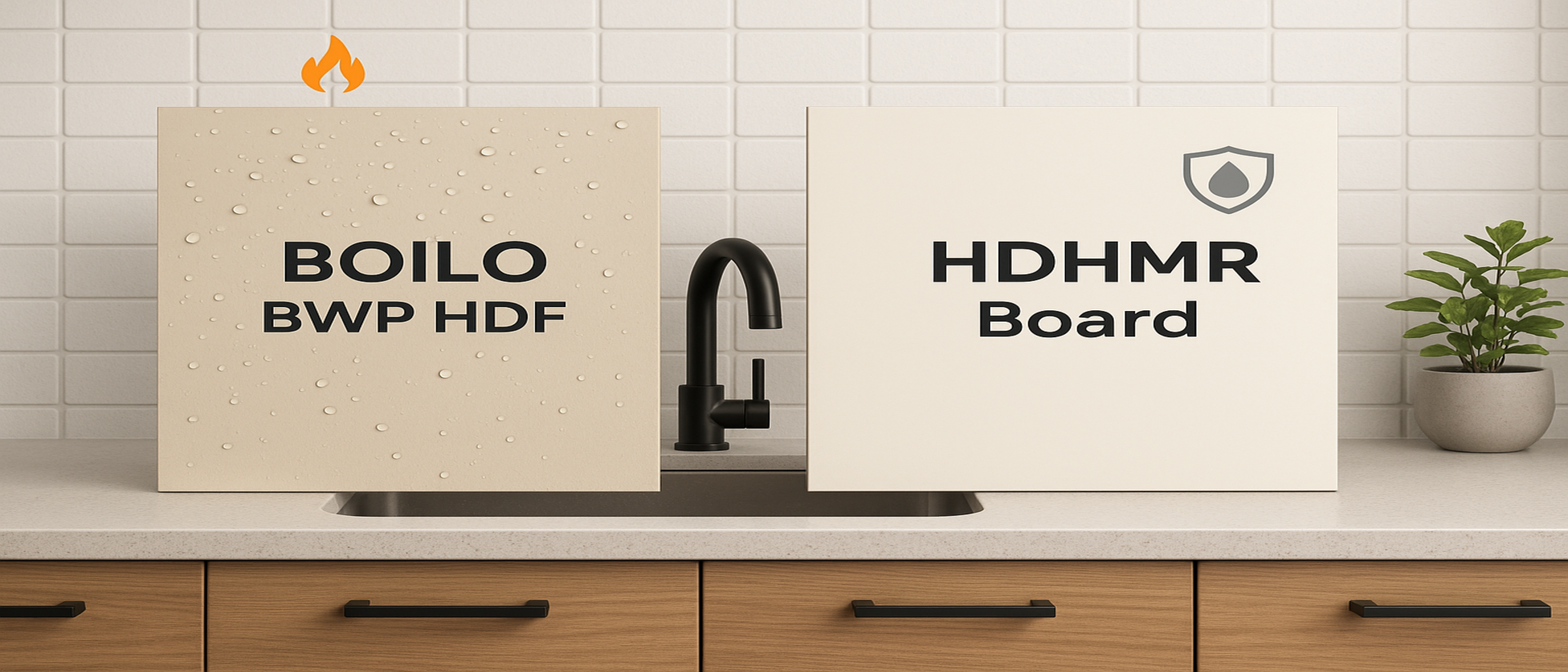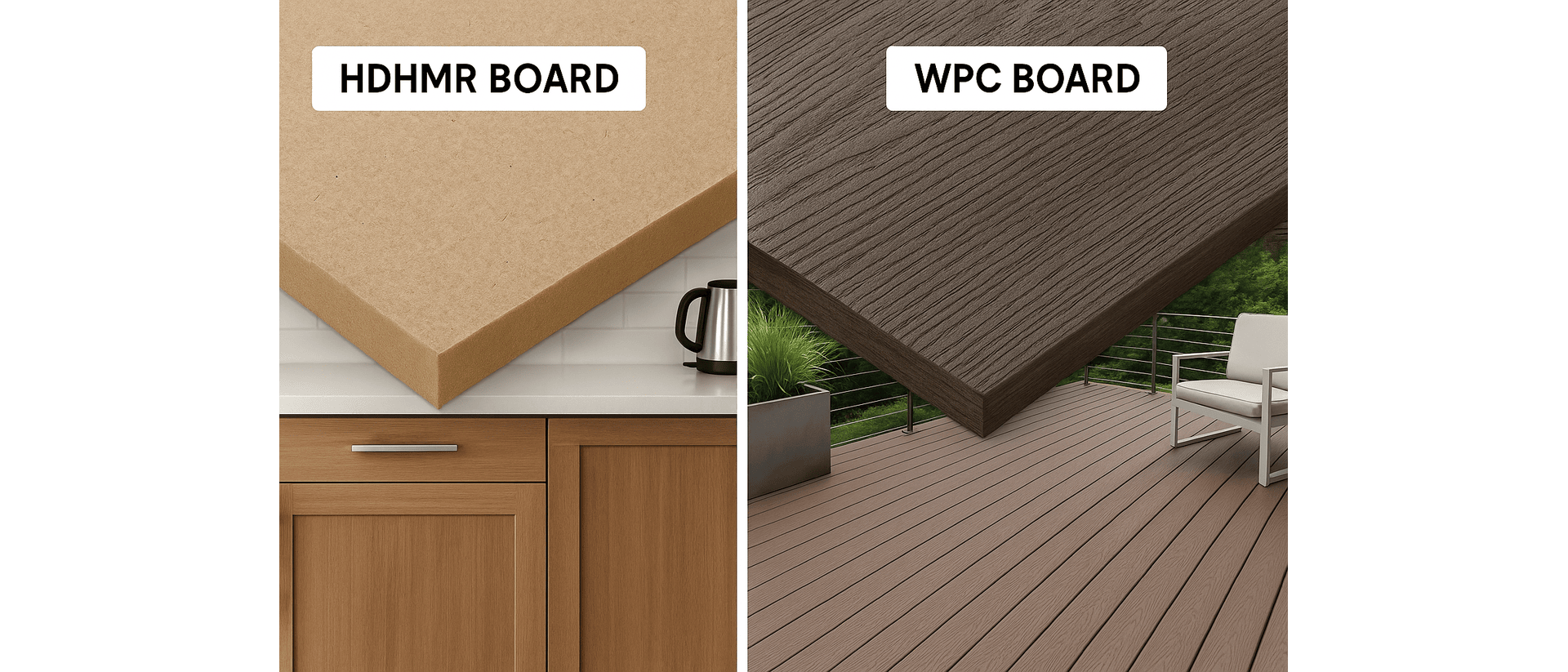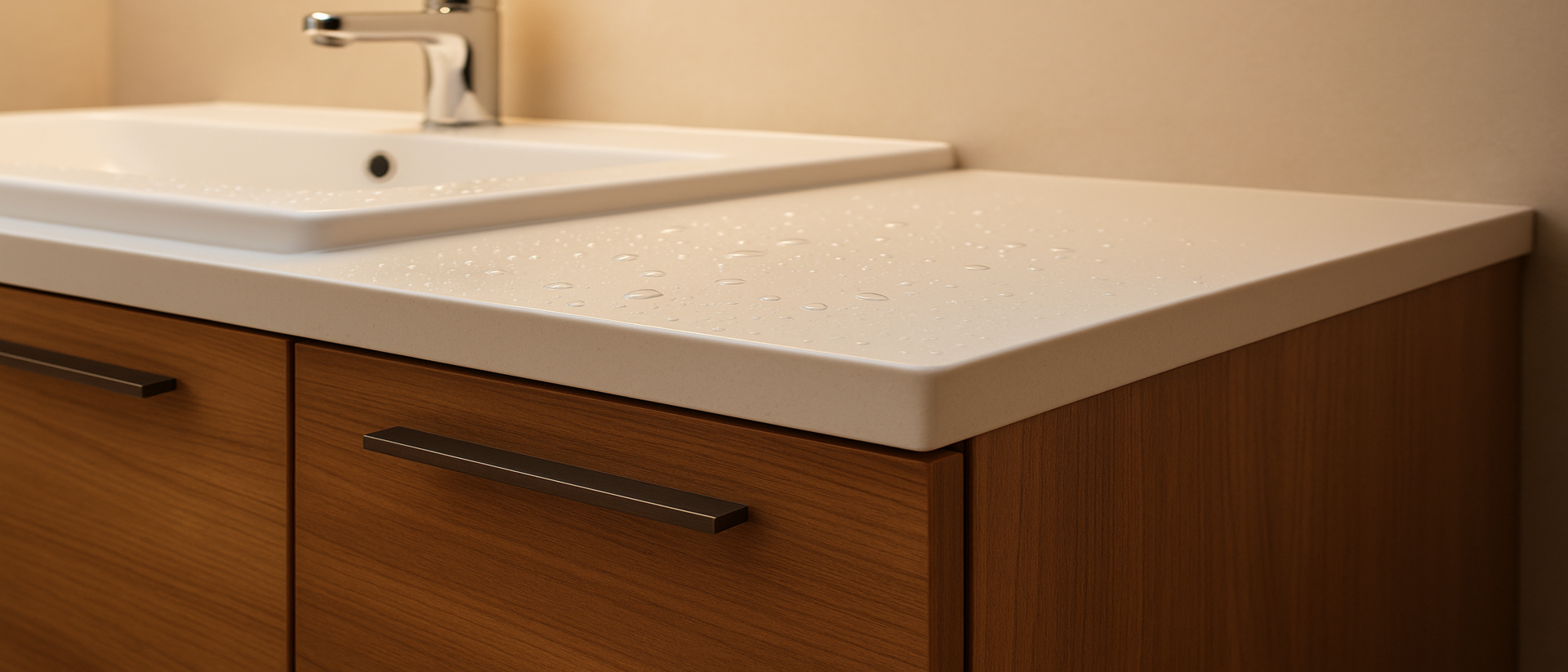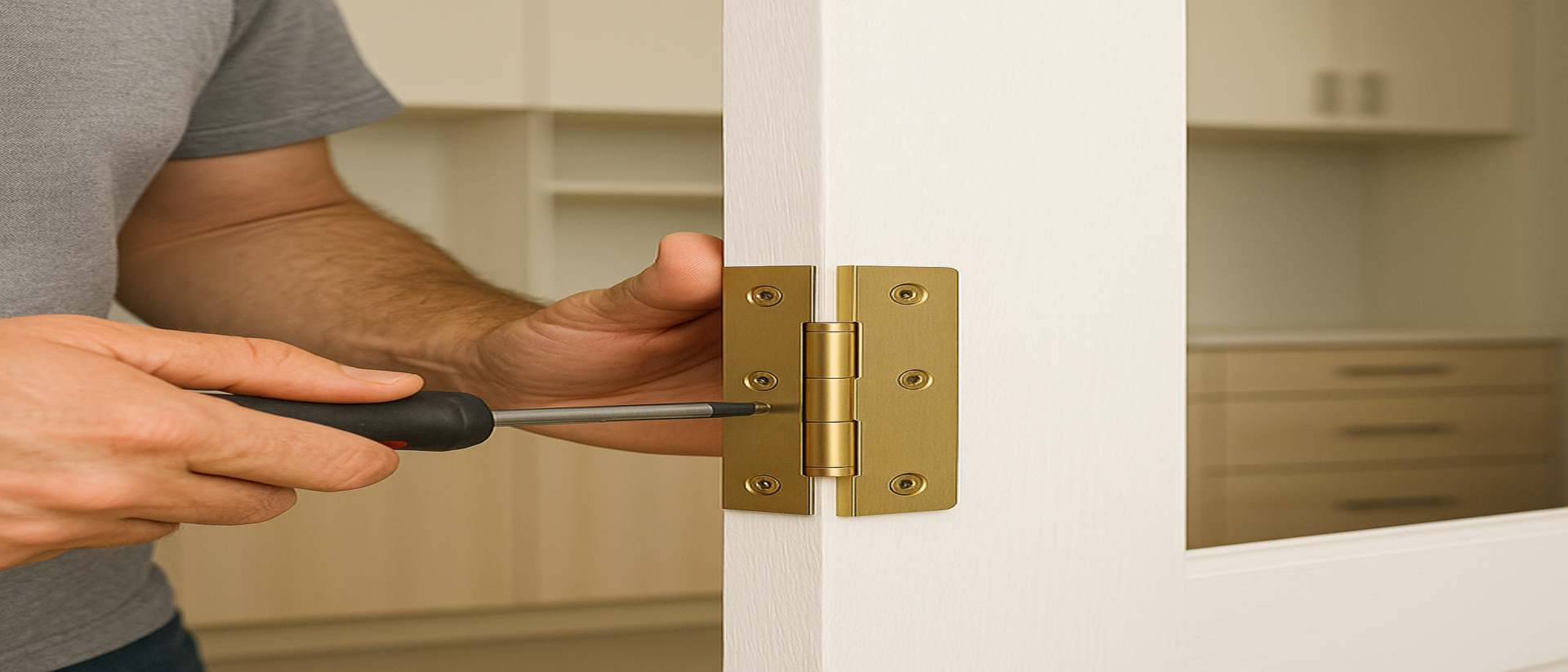For anyone renovating or building a kitchen, the material used for cabinets is a critical decision. Kitchens are wet, busy, and demanding environments for woodwork. HDHMR board has emerged as a popular material for kitchen cabinetry, but is it actually good for kitchen cabinets? The short answer: Yes, HDHMR board is excellent for kitchen cabinets, thanks to its moisture resistance, strength, and termite-proof nature. Let’s dive into the reasons.
Moisture Resistance – The Kitchen Game-Changer
Kitchens see a lot of moisture: steam from cooking, occasional water spills, and generally higher humidity (especially in Indian kitchens with heavy cooking). Traditional cabinets made from normal plywood or particle board often suffer – they warp, delaminate, or get moldy over time if not waterproof grade. HDHMR boards, being High Density and High Moisture Resistant, handle kitchen humidity exceptionally well.
· HDHMR does not warp or swell easily when exposed to moisture. As noted in one interior design guide, “an HDHMR sheet will not warp or separate when exposed to high levels of moisture, not even if you frequently spill water on it.”. This is a huge endorsement for kitchen use – it means the sink cabinet, the carcasses next to your dishwasher, or cabinets near the stove (steam) will stay structurally intact over the years.
· In contrast, MDF or low-grade plywood in a kitchen can start swelling or delaminating within a few years of exposure to moisture. HDHMR’s special resin and density prevent that. It’s also why many modular kitchen manufacturers are shifting to HDHMR for the cabinet carcass (the inner box structure), as it outlasts even BWR (boiling water resistant) plywood in many cases.
· Real scenario: In coastal cities like Mumbai or Chennai, or even in high-humidity times like monsoons, kitchen cabinets often complain of sticking drawers or doors due to slight swelling of material. HDHMR largely eliminates this issue. Your shutters and drawer fronts made from HDHMR will continue to open smoothly as they won’t expand with moisture (as long as they are properly sealed/laminated on the surface).
Durability and Load Bearing
Kitchen cabinets take a beating – we load heavy utensils, pantry items, and they see constant opening/closing.
· Strength: HDHMR boards are dense and can bear weight without bending. Shelves made of HDHMR can hold heavy casserole dishes or bags of grains without sagging (assuming appropriate thickness is used, usually 16mm or 18mm for shelves). The high screw holding capacity means the hinges of your cabinet doors remain firmly attached even with daily use. No one wants a kitchen door coming loose – HDHMR’s density ensures screws grip tight.
· Wear Resistance: The surfaces of kitchen cabinets need to handle some wear (sliding plates, occasional knocks). HDHMR’s compact surface under a laminate or paint is quite resistant to dents. Also, because it has no voids (unlike some plywood), there’s no chance of a weak spot that can cave in. It’s a solid panel throughout.
· Longevity: Many find that HDHMR cabinets last longer than even some marine plywood cabinets in modular kitchens. Plywood can delaminate at edges if not sealed perfectly, whereas HDHMR is a homogenous product – nothing to delaminate. Over 10-15 years, an HDHMR kitchen holds up very well. It’s also completely safe to use with any cooktop or chimney heat – no issues there since it’s heat-pressed and often more fire-resistant than wood (though it can still burn, it has resins that char rather than flame up).
Termite and Pest Resistance
Kitchens can attract pests, including termites, especially if there are even tiny gaps or if lower-quality wood is used. HDHMR boards are typically termite and borer resistant due to chemical treatments and the resins in them.
· If you live in a region prone to termite infestation (some parts of India have periodic termite swarms), having HDHMR cabinets adds a layer of security. Termites generally do not eat HDHMR because of the adhesives and density – it’s not appetizing to them compared to raw wood or low-density particle board.
· This means your kitchen cabinets won’t become a surprise meal for pests, and you won’t have to deal with the nightmare of hollowed-out wooden cabinets (a known issue when cheap plywood or particle boards are used and termites attack).
HDHMR vs Plywood for Kitchens
Traditionally, the gold standard for kitchen cabinets in India was BWR/BWP plywood (water-resistant or boiling waterproof plywood), usually laminated with a shiny laminate. However, HDHMR offers some advantages over even these plywoods:
· Better Moisture Resistance Per Cost: While marine plywood is water resistant, prolonged humidity can still cause slight warping or fungus if not treated. HDHMR boards are more uniformly moisture resistant throughout the material. Interestingly, some industry sources note that HDHMR boards are actually more cost-efficient than BWR plywood for interior applications like kitchen cabinets – meaning you might pay less or equal and get better performance in moisture.
· Surface Finish: HDHMR has a smoother surface than plywood, so when you laminate it, the finish is extremely flat and seamless. Plywood might have slight undulations due to grain which show if laminate is thin. For the ultra-sleek modular kitchen look (especially high gloss finishes), HDHMR gives a perfectly smooth base. Also, edge banding (the PVC/ABS edge strips) adheres nicely to HDHMR edges, resulting in clean lines.
· Uniform Quality: Plywood quality can vary (knots, core gaps, etc. if it’s not a premium brand). HDHMR quality is uniform – every part of every sheet performs the same. This uniformity means no weak spots in a cabinet. Also, large kitchen manufacturers like it because it’s consistent and machine-friendly, leading to fewer rejections or surprises.
· Heavier Weight: One point to note – HDHMR is heavier than plywood. So your kitchen boxes will weigh more. This has a structural implication: you need to ensure wall-mounted cabinets have strong anchors (but that’s true for any material when loaded with dishes). The extra weight is a result of density, but when installed correctly, it’s not a downside, rather it speaks to solidity.
· Waterproofing: If there’s one thing marine plywood still slightly edges out in, it’s absolute waterproofness. If you had a flood in the kitchen (several inches of water standing), marine plywood might resist delamination a bit longer than HDHMR which might eventually soak at edges. However, for everyday “wet usage,” HDHMR is virtually as good as marine ply. You generally wouldn’t submerge your cabinets; and any spills/cleaning water is easily handled by HDHMR (especially if laminated). Also, HDHMR doesn’t require additional waterproof coatings like some plywood users do (people often coat ply with primer or sealant before using in kitchen; HDHMR can be used directly with laminate).
Practical Tips for Using HDHMR in Kitchen Cabinets
· Use proper finishing: Ensure all surfaces of HDHMR are laminated or painted/sealed in a kitchen. While HDHMR core is moisture resistant, you still want the surfaces protected from direct water contact and for ease of cleaning. Laminate on HDHMR works great – gives you a waterproof, wipeable surface. Edge banding should cover all exposed edges to prevent any water seepage into the core (same practice as with any cabinet).
· Choose thickness wisely: For cabinet carcasses (the box), commonly 16mm or 18mm HDHMR is used. For cabinet backs, many modular systems use a thinner 8mm or 9mm HDHMR or HDF – which is fine if the back isn’t structural. Shelves that span wide (over 2 feet) – consider 18mm for no sag. Doors can be 16mm with edge band, or if you want a fancy routered design on the door, some use 18mm and carve a design into it (HDHMR’s routing capability allows for Shaker style or patterns).
· Hardware compatibility: HDHMR works with all standard kitchen hardware – hinges, drawer slides, etc. Just ensure screws are of good quality. It actually holds screws better than many plywoods, so you likely will have fewer instances of screws loosening. Still, it’s good practice to use Euro screws or insert sleeve anchors for hinges on any composite material for longevity.
· Under-sink cabinets: These see the most moisture (from plumbing leaks, etc.). With HDHMR, you already have an advantage. You can go a step further and use a rubber mat at the base or apply an extra coat of waterproof paint at cutouts for pipes, just for extreme scenarios. But generally, users report under-sink HDHMR cabinets remain unaffected by the occasional leak, whereas MDF cabinets would be ruined and plywood might delaminate if water sits.
Real-Life Case: HDHMR Kitchen in Bangalore
(Hypothetical but based on common experiences)
A homeowner in Bangalore decided to go with HDHMR boards for their modular kitchen in 2023. After two monsoon seasons and everyday cooking, the HDHMR cabinets look as good as new. They observed that there was no swelling at the cabinet near the sink where water splashes occur. The shutters align perfectly, indicating no warping. The carpenter who installed it initially recommended marine ply, but now he’s convinced HDHMR was a better choice seeing its performance. The homeowner is also happy that even though they paid slightly more for HDHMR than ply, they got a termite-proof and maintenance-free kitchen. This mirrors many others’ experiences – HDHMR kitchens simply hold up better over time, validating that it is indeed good for kitchen cabinets.
Conclusion
Yes, HDHMR board is not just good, but one of the best materials for kitchen cabinets in today’s context. It provides a combination of moisture resistance, strength, and longevity that is well-suited to the rigors of a kitchen. Many modular kitchen brands and interior designers in India now explicitly offer HDHMR as the base material for cabinetry, reflecting confidence in its performance.
If you are planning a new kitchen or renovating, opting for HDHMR cabinets means you are investing in a kitchen that will stay trouble-free for years – no swollen panels, no termite worries, and solid structural integrity. Just ensure you get genuine HDHMR (from known brands) and have it properly finished. With that, you’ll likely join the growing number of homeowners who swear by HDHMR for a beautiful, durable kitchen.
Disclaimer: This article is generated using AI-assisted research and is intended for informational purposes only. While we strive for accuracy, readers are advised to verify all technical, pricing, and brand-specific details with official sources. hdhmr.in is not liable for any decisions made based on this content.




